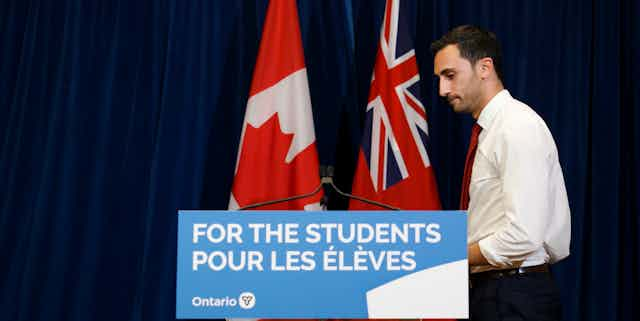Tensions and labour unrest continues in Ontario between the current government and workers in schools. After a labour negotiation impasse in early October, some parents were recently left wondering whether kids’ schools were set to close because of strikes.
On Oct. 6, the Canadian Union of Public Employees (CUPE), representing workers such as school custodians and educational assistants, announced a new collective agreement, but labour action by teachers also remains a looming possibility.
Education workers across the province have denounced education cuts that mean inadequate funding to cover basic student needs and school services, and leave teachers with excessive workloads.
Simultaneously, this fall, striking students and youth hit the streets. Thousands of protestors, some of whom ditched classes, marched on Queen’s Park in Toronto in solidarity with climate activists globally. As a follow-up, climate activists blocked a road intersection in Toronto and such actions have continued across the country and the globe.
Fundamental tensions
There are commonalities in the nature and focus of these recent protests by education workers, students, youth and members of society. What may appear to be disparate concerns point to more fundamental tensions.

Concerns over education, labour and the environment all direct attention to the need for change. All groups want change that will allow them a say in building a better future.
Both climate movements and labour movements denouncing education cuts and asserting education worker rights have provided platforms for people to contest, among other things, what they perceive as an injustice: a secure and sustainable future being taken from themselves, young people or future generations.
Both the current labour and climate insecurities remain inextricably connected to our fundamental social and economic relations.
Securing a future
In both the labour and environmental movements, we increasingly see many younger people wrestling with the dual threats of economic and environmental insecurity and recognizing the current and future costs which socioeconomic structural conditions have forced them to shoulder.

The world of work has become more insecure. Numerous indicators point to a new generation of young workers with dramatically different social relations than in the past.
In 2018, Canadian students owed $28 billion in student debt. Long-term educational debt remains a reality for a larger number of new graduates across the province, and there are a growing number of insolvencies. Precarious work is a reality across both private and public sectors.
Housing also remains a problem for many young people. In the Greater Toronto Area (GTA), almost half of young adults live with their parents (47.4 per cent) and such choices are typically determined by financial rather than personal considerations. In parts of Ontario such as Toronto, home ownership appears to be increasingly out of reach. Child-care costs (for those who want to have children) are also deeply unaffordable, posing significant challenges.
Distribution of wealth
Part of the problem appears to be rooted in the nature and distribution of work and wealth. In Canada, as in many industrial economies, average hourly wages have remained essentially stagnant over the past 40 years.
At the same time, economic inequality has continued to rise, benefiting a small minority while more precarious forms of work, which tend to impact youth hardest, have continued to proliferate. Both unemployment and underemployment (or a “skills mismatch”) continues to be problematic.
While all these issues are extremely complex, what can be generally inferred is that the current generation of youth and workers may not end up “better off” — both economically and ecologically — than their predecessors.
Intergenerational inequity
During my research with unemployed and underemployed teachers, I came upon the concept of intergenerational equity that captured the anger and frustration felt by many young educators. They felt a profound sense of unfairness in the labour market — that in the past, it was easier to get ahead, and to build a life, in comparison to their current experiences. Adding to this frustration was the belief that they had little power to fix this situation.
Read more: Precarious employment in education impacts workers, families and students
The term intergenerational equity refers to arguments surrounding the equitable usage of resources between generations, typically grounded in values of fairness or justice. The concept stresses that communities and societies are constituted by partnerships between generations. It also implies that existing generations must think beyond themselves to the future. Thus it captures some of what contemporary worker activists and environmentalists are talking about.
Youth activist Greta Thunberg’s recent words, “We will never forgive you,” highlight the generation tensions of “us versus you” within the environmental movement. Such statements pronounce that we shouldn’t sacrifice the future for the present and that long-term goals must be considered over short-term gains.
Such debates about what is fair surely have long histories, but today both unprecedented degrees of wealth inequality and climate change simultaneously appear increasingly unsustainable.
When intergenerational fracturing occurs, and when the right to securing a future appears unachievable, citizen anger risks erupting in ways which may not be in the best interest of workers, the environment or democracy.
No shortage of solutions
There is no shortage of possible solutions to current work, labour and climate issues. Ideas and proposals considering “new capitalism,” a basic income or the “Green New Deal” all appear to be gaining momentum. All seek to fundamentally redefine our relationship with both work and nature.
As downward mobility and ecological fragility becomes increasingly normalized, our society has perhaps become used to lowering expectations concerning economic security, precarious employment, labour solidarity and environmental degradation.
There is no better time than the present for youth, activists and education workers to assert their rights to the future. This includes not only having a voice, but actively securing educational and environmental conditions that will allow future generations to thrive.
[ Deep knowledge, daily. Sign up for The Conversation’s newsletter. ]

